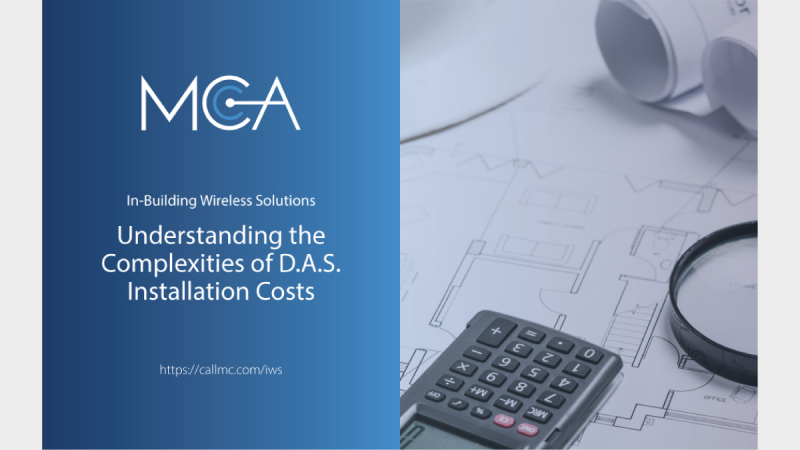
Exploring the Variable Pricing of DAS Systems
Deploying a Distributed Antenna System (DAS) is key to ensuring consistent wireless communication and comprehensive coverage within buildings. However, pinpointing the exact cost of installing a DAS presents a complex challenge for System Integrators due to the unique nature of each project and a host of influencing factors. This complexity stands in stark contrast to standard products that come with fixed prices.
DAS System Integrators, such as the IWS team at MCA, typically provide cost estimates as ranges. This approach remains until a detailed site survey and RF benchmarking test have been conducted within the targeted facility.
Key Factors Influencing DAS System Costs
DAS pricing is influenced by a variety of components, involving both materials and labor.
Materials:
- Active Materials: These include electronics or components that are critical for DAS functionality.
- Passive Materials: These are infrastructure components necessary for supporting DAS operations.
Services:
- Survey and Engineering: Involves gathering benchmark data and conducting assessments.
- Construction: The physical construction and installation phase of the DAS.
- Commissioning, Integration, and Activation: This phase includes setting up the DAS, integrating it, and bringing it online.
Notably, maintenance costs post-construction become operational expenses and are not included in the initial service list.
Project Management Options
Project management can be handled internally or outsourced. The choice often depends on the project's scale and can include both field and overall project management tasks.
Breaking Down the Bill of Materials for a DAS
The bill of materials for a DAS can initially appear overwhelming but becomes more manageable when categorized into six main sections:
- Electronics: These are the primary, power-reliant devices, often heavy.
- Cable and Connectors: Includes coaxial cables and fiber, crucial for signal transmission.
- Antennas: The essential components for signal broadcasting.
- Jumpers and Couplers: These are the smaller cables and components used for connections.
- Support Structure: Items used for holding or supporting other components, like racks and cable management systems.
- Grounding: Components designed to protect the system from electrical surges.
Delving Into the Bill of Services
The construction of a DAS encompasses several critical steps, ensuring the system's functionality and reliability:
- Cable Installation: Involves laying out and connecting coaxial and fiber cables.
- Mounting Electronics and Antennas: Placement of antennas and electronics is strategic to facilitate optimal signal transmission and reception.
- Grounding, Labeling, and Powering: Ensuring safety through grounding, clear labeling for maintenance, and proper system powering.
- Making Interconnections: Connecting devices and electronics through cables.
- Cable Testing: Essential tests to check for faults and ensure signal integrity.
The Importance of Site Surveys and RF Benchmarking
Given the multitude of factors at play, DAS System Integrators conduct detailed site surveys and RF benchmarking to accurately assess each facility's specific needs. This approach helps tailor the solution to ensure optimal performance and regulatory compliance.
Price Ranges: A Necessity for Flexibility and Transparency
The unique aspects of each DAS project make fixed upfront costs impractical. System Integrators, like MCA, offer price ranges based on their experience and industry standards, aiming for transparency while accommodating the specifics of each project.
Further Exploration of DAS Pricing Influencers
To fully grasp the cost considerations, it's important to understand the detailed factors impacting DAS pricing, such as:
- Building Characteristics: Size, type, and internal RF environment.
- Location: Impacts labor rates, permit fees, and resource availability.
- Travel and Parking: Logistics and accessibility for technicians and equipment.
- Building Size and Type: Larger or more complex buildings require more extensive DAS installations.
- Internal and Rooftop RF Environments: Affect signal propagation and may necessitate specialized solutions.
- Technical and Infrastructure Requirements: Including existing systems, power needs, and cable management.
- Desired Frequency Band and Carrier Involvement: Specific frequencies and carrier requirements can significantly influence costs.
DAS Estimating Overview
The multifaceted nature of DAS installations means that costs can vary widely, influenced by local regulations, the complexity of the installation, and the specific needs of the facility. While exact prices may not be listed online, providing a range offers a flexible and transparent starting point until a comprehensive assessment can be made. Through close collaboration with clients, DAS System Integrators can develop customized solutions that ensure efficient and reliable wireless communication across facilities.
Start The Estimating Process >>
About MCA
MCA is one of the largest and most trusted DAS integrators in the United States, offering world-class voice, data, and security solutions that enhance the quality, safety, and productivity of customers, operations, and lives.
More than 65,000 customers trust MCA to provide carefully researched solutions for a safe, secure, and more efficient workplace. As your trusted advisor, we reduce the time and effort needed to research, install, and maintain the right solutions to improve your workplace.
Our team of certified professionals across the United States delivers a full suite of reliable technologies with a service-first approach. The MCA advantage is our extensive service portfolio to support the solution lifecycle from start to finish.
